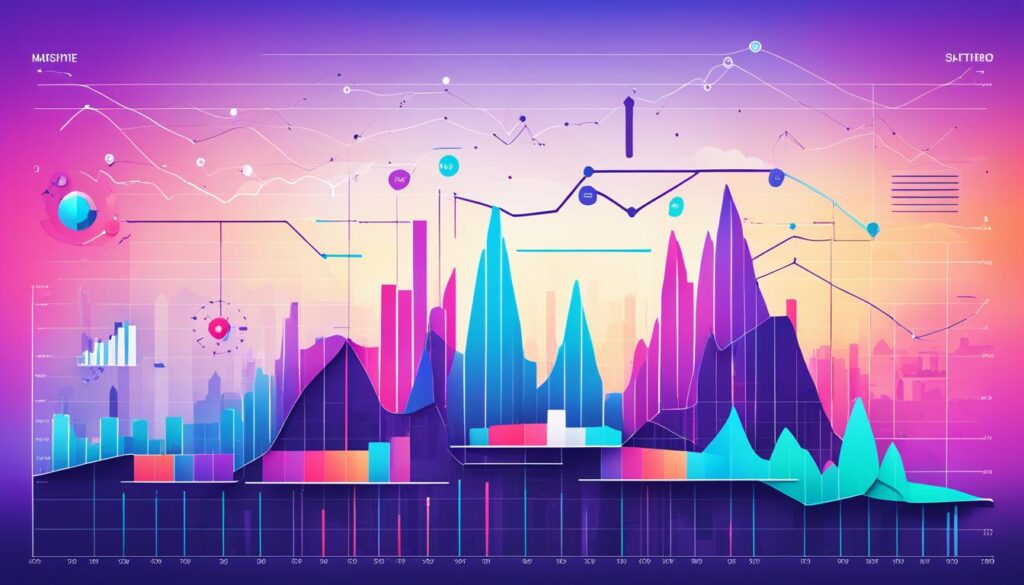Software acquisition is changing a lot, mainly because of more mergers and acquisitions (M&A). This change comes after a tough time. Now, Brian Levy from PwC US says we’re entering a new, better phase. This phase will be full of smart changes and market adjustments.
With this shift, those making deals need to be sharp. They’re facing higher costs and world issues, so they must act fast and show the value of their strategies.
The world of energy, tech, and pharma is moving quickest in this change. Banking and healthcare, however, are moving more slowly. This change shows the need for acquisition plans that match what’s happening in the markets and take bold steps.
Key Takeaways
- Anticipated resurgence in M&A activities is transforming the software acquisition market.
- Higher capital costs and geopolitical uncertainties are key challenges for dealmakers.
- Energy, technology, and pharmaceutical sectors are at the forefront of this transformation.
- Banking and healthcare may experience a slower adoption process.
- Importance of strategic agility and clear value demonstration for successful deals.
The Current State of the Software Acquisition Market
The software acquisition market analysis shows important predictions and insights on the current scene. We see a dip in global deal values and volumes. But, there’s hope for a comeback, especially in the mid-market.
In 2023, big players like Exxon and Chevron made major purchases. This led to more big deals, with expectations for 2024 to be promising.

This progress is influenced by several factors. These include changes in company values, high multiples, and the state of the IPO market. There’s a push for mergers and acquisitions from companies looking to grow. They want to strengthen their position in uncertain economic times.
- The SaaS industry has soared, now boasting over 175,000 companies, especially those focusing on AI. This shows a big future for AI in SaaS.
- AI-based SaaS has caught the attention of private equity. There were big deals, like Silver Lake’s purchase of Qualtrics International for $12.25B and Alteryx’s acquisition for $3.46B by Insight Partners and Clearlake Capital.
- Other notable buyouts include Hewlett Packard Enterprise Company’s buy of Juniper Networks for $12.8B and IBM’s purchase of Apptio for $4.6B.
- The Software Development Service Market’s CAGR from 2024 to 2032 is predicted at 14.81%.
- Its market size, valued at USD 329,442.46 million in 2022, is expected to grow to USD 754,395.61 million by 2028.
A key player in these trends is the high AI adoption rates in SaaS. Most SaaS vendors are now offering AI/ML features. This ongoing analysis hints at a cautiously optimistic future for the software acquisition sector.
The Role of Mergers and Acquisitions in Software Procurement
Mergers and acquisitions (M&A) are key in software procurement’s evolution. They create chances for growth and new ideas. This helps companies boost their tech skills and get better spots in the market.
Recent Trends in Software M&A
The software world has seen big changes in M&A lately. There have been a lot of mergers and big deals starting up. For example, Broadcom bought VMware for $69 billion. It took the deal 59 weeks to get through the rules.
Microsoft’s buyout of Activision also faced a long check by the government. The check took nearly two years. Such high scrutiny has made companies focus on smaller buys. These are easier to manage with less red tape. Companies also aim to buy startups to boost innovation. The focus is often on those with new AI tech.
Future Predictions for Software Deals
The future of software mergers will see a lot of new tech behind them. Things like blockchain, AI, and edge computing. Companies want to use these to stay ahead. Cloud tech will also keep being a big deal in these mergers. It helps companies offer better services or do more things.
| Acquisition | Value | Duration of Scrutiny |
|---|---|---|
| Broadcom’s Acquisition of VMware | $69 Billion | 59 Weeks |
| Microsoft’s Proposed Acquisition of Activision | — | Almost 2 Years |
Big tech companies will keep growing bigger. But they’ll face closer checks from the government. This means companies have to be careful in how they merge. They have to share the same culture and boost new ideas. This is just as important as the money part.
Using analytics is a big deal now. Companies wants to merge with firms that are good with data. This gives them an edge with smart insights. Plus, energy change is also pushing mergers. Now, companies are looking to match Europe’s green energy goals.
One main challenge in buying software is putting the new tech together. And also making sure the new software rights are all good. Tools like LicenseAnalyzer help a lot. They check on how software is used. And they predict what new software a merged company might need.
Technological Advances Driving Software Acquisition
New tech like artificial intelligence (AI), machine learning (ML), and the Internet of Things (IoT) are pushing companies to buy software. They want to stay ahead with these advanced tools, making buying other firms an appealing option.
The number of SaaS companies has jumped from 72,000 to over 175,000, showing AI’s key role in SaaS growth. Big investments have gone into AI, like Qualtrics and Alteryx. This proves how much the SaaS world values AI.
Big companies are buying firms that focus on AI. This includes Hewlett Packard Enterprise acquiring Juniper Networks and IBM taking over Apptio. This shows AI’s big strategic role in not only tech but all sectors.
Most SaaS sellers are now adding AI/ML to their products. This shows how popular these technologies have become, spreading into various fields like marketing and healthcare. Companies such as HubSpot and Siemens use AI to improve their businesses.
AI is making the SaaS sector more efficient and profitable, attracting more buyers and investors. It’s clear that AI is not only new but also really powerful, promising better business results. That’s why many are buying into cloud software to keep up.
To sum up, AI, ML, and IoT are redefining how software companies grow. They drive innovation and push companies towards technology-focused futures.
The Future of Software Acquisition: Predictions and Insights
In the world of software acquisition, big changes are on the way. New tech will lead the charge, making predictive analytics a key player. This means companies will use tools like AI and machine learning to get custom solutions. With this, they’ll find new ways to be efficient and gain insight.

Impact of AI and Machine Learning
Artificial intelligence (AI) and machine learning will deeply change how software is acquired. For example, Pronix Inc uses these to totally change how they find new team members. They use AI to make smart predictions, like with decision trees and neural networks. This helps them sift through data to hire better, ultimately running more smoothly. This tech is crucial for how future software deals will go down, pushing for smarter and more flexible choices.
Cloud Computing and Software Deals
Cloud computing is reshaping how software is bought, with companies increasingly choosing cloud-based options. The Talent Acquisition Software Market is set to grow significantly between 2024 and 2032. This trend is led by a desire for flexible, cloud solutions in areas like pharmaceuticals and retail. Cloud tech makes it easier to blend systems and handle data, fitting well with the future’s call for agility and advanced tech.
The global market for predictive analytics is set to explode, going from $12.49 billion in 2022 to about $38 billion by 2028. This 20.4% jump shows the big role predictive analytics and the cloud will play in software’s future. They’ll promote new ideas and keep companies sharp as tech keeps evolving.
| Factors | Details |
|---|---|
| Market Growth | Significant growth of Talent Acquisition Software Market between 2024 and 2032. |
| Technological Drivers | AI, Machine Learning, and Cloud Computing. |
| Applications | Pharmaceutical, Biotechnology, BFSI, Retail, IT & Telecom, Healthcare, Government, Education. |
| Market Size | Predictive analytics market projected to grow from $12.49 billion in 2022 to $38 billion by 2028. |
| Impacts | Enhanced predictive analytics, optimized resources, innovative cloud-based solutions. |
Best Practices for Navigating the Software Acquisition Process
Getting through software acquisition well needs a full strategy. It brings together big picture planning, detailed checks, and working closely with others. They make sure you’re buying software that fits your team’s big goals.
Effective Strategies and Tactics
Using the right moves during software buying makes all the difference. Start with clear goals:
- Robust M&A Strategy: Make a strong plan for mergers and acquisitions that fits your organization’s future plans.
- Financial Health Evaluations: Look closely at the finances of software you’re thinking of buying to make sure they’re in good shape.
- Partnering with Investment Banks: Get advice from investment banks. They can help you understand the finance and strategy side better.
- Investment in Innovation: Keep up with new tech trends and invest in new ideas. This keeps your team ahead in the game.
Challenges and How to Overcome Them
The software buying road has its bumps, but you can smooth them out with smart action. Here’s how:
- Maintaining Financial Stability: It’s key to keep your finances strong. This lowers risks and deals with surprises during the buy.
- Talent Acquisition: Snagging new, creative minds helps your team grow and get better after the buy-in.
- Contingency Planning: Having plans ready for what could go wrong helps you act fast and smart in tough situations.
Following these steps can help your organization do great in software acquisitions. They cut down on risk and up the reward. For deeper tips on tackling today’s market changes, check out a software outsourcing market analysis.
Conclusion
The way we get software is changing fast, thanks to new tech like AI and cloud computing. By 2025, it’s expected to hit $33.3 billion. This shows a deep growth and connection within the Business Intelligence (BI) field. With these changes, handling data for important decisions is getting more complex.
Self-service BI is becoming more popular. It lets people in organizations check and use data on their own. This sharing of data across the board helps everyone move quickly and smartly towards dealing with business problems. Also, using predictive analytics is making decision-making even better.
Then there’s Natural Language Processing (NLP). It’s bringing big wins for businesses by making technology easier to use and understand. Thanks to cloud-based Business Intelligence-as-a-Service, costs are down. This full-package solution is making getting software easier. Pretty soon, working together using shared insights within big systems will be very common.
The way we acquire software is heading towards a high-tech future. Staying ahead in the game will mean using new and smart strategies. By being creative, bringing in experts from all over, and making the most of data, companies can do well. The key will be to keep up with the fast changes and plan well in this busy digital market.




